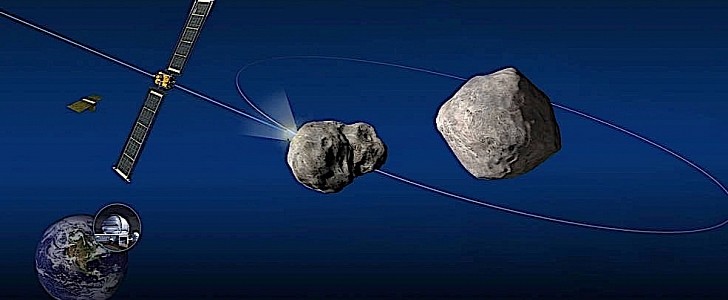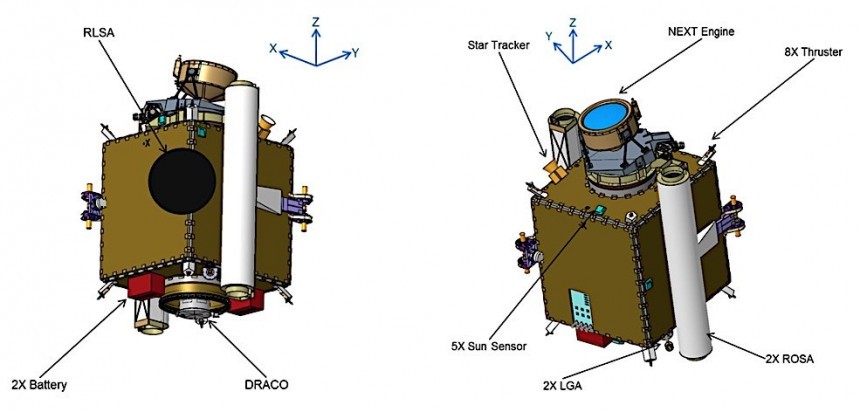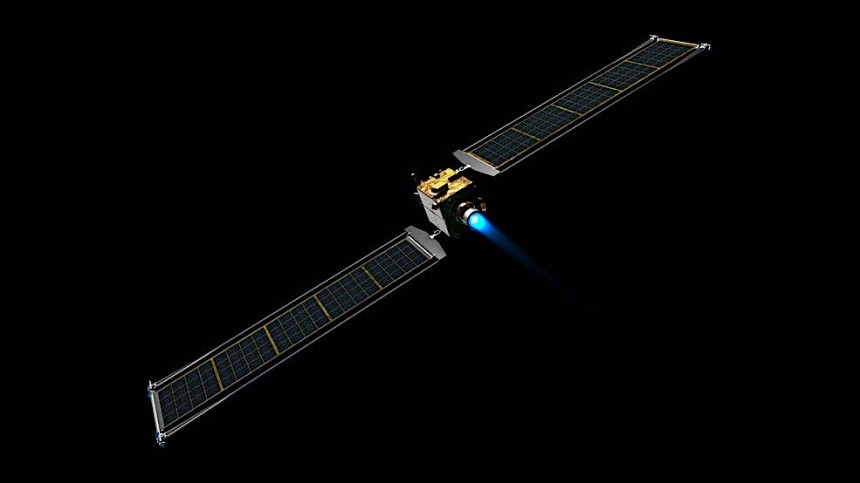There have been so many disaster movies that envisioned our world on the verge of being obliterated by asteroids and other types of space hazards, that we lost track of them all. But we do remember that in pretty much all of them, humans were struggling to mount some type of defense. And soon, what you saw imagined there might become a reality.
The most recent NASA data on asteroids paints a grim picture. There are more than 25,000 asteroids circling the solar system like a huge pack of hungry wolves, and over 9,000 of them are listed as near-Earth objects. But that’s only the ones we know about, as there are potentially 15,000 more of them out there, still left to discover, moving unseen on some potentially dangerous paths.
If one of those asteroids were to head our way, probably all hell would break loose. A tabletop exercise (check PDF attached below for more) conducted by NASA back in May showed that at the moment there’s nothing humanity can do to stop an asteroid from slamming into Europe, for instance, not even with six months of advance warning.
During the exercise, several defense scenarios were tried out. The first one was deflection, meaning hitting the incoming asteroid with something hard and fast enough to alter its course. That was ruled out because, well, six months warning and our current technological level were not enough to change the simulated rock’s course significantly.
Then, NASA imagined how it would be throwing nuclear warheads at the thing, but got stuck in calculating the force needed to obliterate the asteroid. Because it was impossible to determine the asteroid’s composition, it was impossible to determine how big of a nuke should be sent. The largest one available was considered, but even that was deemed useless for asteroids larger than ~100 m to ~210 m, and with densities ranging from 5 g/cm3 down to 1 g/cm3.
What’s more worrying is that with our current technological level, six months would not be enough to get a mission up and running to study the rock closer either, making all other efforts largely useless.
Now, NASA knows an asteroid impact is a matter of when, not if. And it is planning on doing something about it, at least to give us the impression we still have a fighting chance.
Since 2018, a number of agency branches have been working on something called DART. That is short for Double Asteroid Redirection Test, and it is in essence a suicidal spacecraft sent into the void to prove whether all that fancy talk about deflection in movies, literature, and tabletop exercises, is worth anything.
DART is scheduled to take off on top of a SpaceX Falcon 9 rocket from Vandenberg Space Force Base this November. It will head out into space, homing in on a binary asteroid called Didymos, and plans of slamming into the thing in the fall of 2022 at speeds of 15,000 mph (24,140 kph), to see if it can alter its course.
DART is a tiny little thing, measuring 12.5 meters × 2.4 meters (41.0 feet × 7.9 feet). It comprises an engine called NEXT to move along, Roll-Out Solar Arrays (ROSA) to give it power, two batteries to store that power, a star tracker to get its bearings, and the Didymos Reconnaissance and Asteroid Camera for Optical (DRACO) to record the moment of impact.
That’s it. No fancy lasers, no nuclear warheads, no humans on board. Just a tiny piece of metal and other materials, thrown from a planet Didymos probably doesn’t even know exist, and meant to prove a point.
Didymos’ main body measures 780 meters (2,560 feet) across, while the smaller, orbiting one just 160 meters (525 feet) across, and DART should not make such a big impact on the space-floating pair of rocks.
It is the smaller asteroid DART is targeting, and the goal it set for itself may seem rather small: change the asteroid’s speed and orbit around the main body by a fraction of one percent. That however translates into a change in the orbital period by several minutes - enough to be seen from Earth using telescopes and prove that yes, humans could eventually deflect asteroids. Provided, of course, we mature the technology fast enough and some other asteroid does not strike us in the meantime.
Despite being the first mission dedicated to seeing if deflection can be a thing, DART will not be the first time humans have abused an asteroid. Back in 2019, the Japanese Space Agency (JAXA) fired a projectile called Small Carry-on Impactor (SCI) from the Hayabusa2 spacecraft, right into the surface of asteroid Ryugu.
The slug hit the surface at speeds of 2 km per second (4,473 mph), causing a crater 2 meters in diameter (6.5 feet). What’s more, boulders on the surface were disturbed within a 30 meters (98 feet) radius from the impact crater center, according to the Kobe University.
That means there is no reason why DART shouldn't work. It only remains to be seen how fast can it lead to something really usefull to defend ourselves.
If one of those asteroids were to head our way, probably all hell would break loose. A tabletop exercise (check PDF attached below for more) conducted by NASA back in May showed that at the moment there’s nothing humanity can do to stop an asteroid from slamming into Europe, for instance, not even with six months of advance warning.
During the exercise, several defense scenarios were tried out. The first one was deflection, meaning hitting the incoming asteroid with something hard and fast enough to alter its course. That was ruled out because, well, six months warning and our current technological level were not enough to change the simulated rock’s course significantly.
Then, NASA imagined how it would be throwing nuclear warheads at the thing, but got stuck in calculating the force needed to obliterate the asteroid. Because it was impossible to determine the asteroid’s composition, it was impossible to determine how big of a nuke should be sent. The largest one available was considered, but even that was deemed useless for asteroids larger than ~100 m to ~210 m, and with densities ranging from 5 g/cm3 down to 1 g/cm3.
What’s more worrying is that with our current technological level, six months would not be enough to get a mission up and running to study the rock closer either, making all other efforts largely useless.
Since 2018, a number of agency branches have been working on something called DART. That is short for Double Asteroid Redirection Test, and it is in essence a suicidal spacecraft sent into the void to prove whether all that fancy talk about deflection in movies, literature, and tabletop exercises, is worth anything.
DART is scheduled to take off on top of a SpaceX Falcon 9 rocket from Vandenberg Space Force Base this November. It will head out into space, homing in on a binary asteroid called Didymos, and plans of slamming into the thing in the fall of 2022 at speeds of 15,000 mph (24,140 kph), to see if it can alter its course.
DART is a tiny little thing, measuring 12.5 meters × 2.4 meters (41.0 feet × 7.9 feet). It comprises an engine called NEXT to move along, Roll-Out Solar Arrays (ROSA) to give it power, two batteries to store that power, a star tracker to get its bearings, and the Didymos Reconnaissance and Asteroid Camera for Optical (DRACO) to record the moment of impact.
That’s it. No fancy lasers, no nuclear warheads, no humans on board. Just a tiny piece of metal and other materials, thrown from a planet Didymos probably doesn’t even know exist, and meant to prove a point.
It is the smaller asteroid DART is targeting, and the goal it set for itself may seem rather small: change the asteroid’s speed and orbit around the main body by a fraction of one percent. That however translates into a change in the orbital period by several minutes - enough to be seen from Earth using telescopes and prove that yes, humans could eventually deflect asteroids. Provided, of course, we mature the technology fast enough and some other asteroid does not strike us in the meantime.
Despite being the first mission dedicated to seeing if deflection can be a thing, DART will not be the first time humans have abused an asteroid. Back in 2019, the Japanese Space Agency (JAXA) fired a projectile called Small Carry-on Impactor (SCI) from the Hayabusa2 spacecraft, right into the surface of asteroid Ryugu.
The slug hit the surface at speeds of 2 km per second (4,473 mph), causing a crater 2 meters in diameter (6.5 feet). What’s more, boulders on the surface were disturbed within a 30 meters (98 feet) radius from the impact crater center, according to the Kobe University.
That means there is no reason why DART shouldn't work. It only remains to be seen how fast can it lead to something really usefull to defend ourselves.










